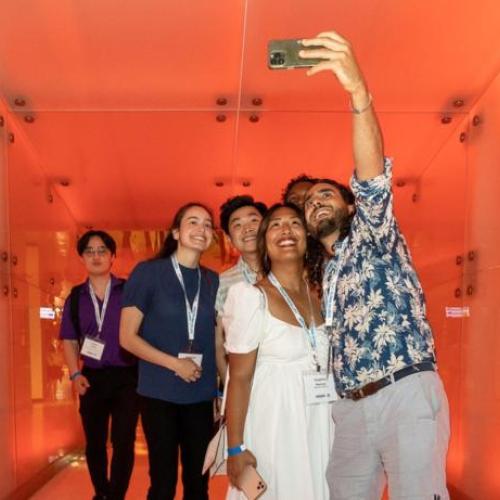May 7, 2024 | Alumni | Campus
Celebrating 100 years of the Soldiers’ Tower
By Megan Wykes

Convocation is a special milestone for all U of T alumni, and a key component of this experience is the bells (carillon) of Soldiers’ Tower. This year marks 100 years since construction of the tower was completed.

There are only 12 carillons in Canada, so the instrument in Soldiers’ Tower is a real gem for U of T. It has 51 bells ranging in weight from four tons to 23 pounds. Dedicated on October 6, 1927, the initial 23 bells honoured members of the University who fell in the First World War. More bells were added in 1952 and 1976 in memory of those who fell in the Second World War.
To commemorate this year's centenary, Daniel Hendrickson, chair of the Soldiers' Tower Committee, will be giving an online lecture entitled The Soldiers' Tower: A Century of History on May 29.
Behind the music

So, who’s behind the bells? U of T has three certified players called carillonneurs (or carillonists) who are all U of T alumni: Roy Lee (JD 2004), Elisa Tersigni (MA 2009, PhD 2018) and Naoko Tsujita (MMus 2018). Naoko is an experienced percussion instructor, skilled in music performance, education and composition. She earned her master’s degree in music performance from the Faculty of Music.
Naoko comes from a very musical family. Her parents are both musicians. Her father, a teacher, led the school band. Her mother taught piano. Her siblings are also musicians. “It was natural for me to start playing instruments,” Naoko says.
After graduating in music performance (percussion), she became interested in carillons. An organ-playing friend showed her one of the oldest in Canada, located in Toronto’s Metropolitan United Church. She went to this church to meet the carillonneur, Roy Lee, and soon after became Lee’s student, taking private lessons while she was completing her master’s degree.
She was enthralled with the carillon from the start. “I just love playing,” she explains. She earned her certificate from the North American Carillon School during the pandemic, a time that was extremely challenging for musicians since venues were closed for lengthy periods of time. In a way, Covid helped her to focus on learning the new instrument, arranging music for it, and learning how to promote and market music.
From practice to performance
Naoko plays the bells during U of T’s convocations, leaning on standard repertoire. “Classical music is popular in the carillon repertoire, especially at the beginning of convocation. There are also so many compositions written for carillon, which are nice to play. Then after the graduation ceremony, I usually play vivid and energetic pieces.”
Informal ‘rings’ are more casual practice sessions on non-convocation days. “I arrange music and test it during this time,” Naoko explains, adding, “I have to try out my arrangements, otherwise I don't really know how they sound!”

Many will be surprised to learn that there are actually two instruments in Soldiers’ Tower – the practice instrument (somewhat like a xylophone and not audible outside) and the actual instrument with the larger bells, which is audible outside. Informal ‘rings’ can be fun for both listener and musician. If anyone happens to be strolling by, they may hear Naoko playing anime works, Beatles pieces or Japanese folk songs. She was once asked to arrange folk songs from seven countries, which she loved.
The importance of public music
It may be public, but unlike almost all other instruments, no one listening to the beautiful music can see the musician behind the sound. “Not many people know there’s actually a human being playing the bells,” Naoko jokes. “They think the music is pre-recorded or automatic.”
Nevertheless, this public music means all kinds of different things to different listeners – passersby, students, graduates, family members, etc. After one performance, Naoko met a woman who was deeply affected by the music. “This lady came up to me and started crying because she had lost her father the day before. She was walking around the area, almost by accident, when she heard the bells. So that was a very meaningful moment for her.”
Working as a carillonneur makes Naoko feel deeply connected to Hart House, Soldiers’ Tower and U of T. “Being in this Tower gives me the feeling that I’m actually a part of the history. That’s special, as is working with members of the Soldiers’ Tower Committee. They know a lot of the history. When we talk about it, I feel as though I am becoming a part of the history and carrying this history to the next generations,” she explains.
To learn more about this unique piece of U of T history, register for Daniel Hendrickson’s Stress-Free Degree lecture, The Soldiers’ Tower: A Century of History.

